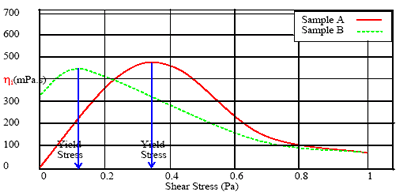Sooty engine oils will develop a microstructure of carbon particles when left to rest, imparting a slightly jelly-like nature.
Structure Formation
If structure forms quickly, then the oil will be immobilized on the engine surface in situ when the engine is stopped and this can form immediate lubrication again on start-up, thus reducing wear. However if the structure becomes too strong, the oil may be inhibited from flowing around the smaller channels.
Resistance To Flowing – Yield Stress
This resistance to flowing is called a ‘yield stress’.
|

|
|
Figure 1. Variation in viscosity with application of stress.
|
On application of stress, a sample with a yield stress initially acts as an elastic solid. In this case the instantaneous viscosity appears to increase as more stress is applied. The sample is effectively absorbing energy and as a result resists flowing.
When the yield stress is reached, the sample starts to flow and the measured viscosity falls rapidly. The peak of the viscosity curve can be used to indicate the yield stress of the sample.
Interpretation Of Results
Nominally, a user can say that Sample A showed a yield stress of 0.35 Pa and will therefore resist flowing much more effectively than Sample B, which showed a showed a yield stress of 0.12 Pa. There is however a more mathematical approach, given below.
Film Thickness
The maximum equilibrium film thickness deposited on a surface will be dependent on the yield stress of the oil, the gravitational forces and the angle of inclination. The equilibrium state can be modeled as:
σyield = ρgh Sin ß (see Figure 2.)
Resistance To Pumping
A coating's resistance to start pumping will also be proportional to its yield stress. It can be seen that the shear stress (at the wall) of a fluid running through a pipe (ignoring entrance and exit effects) is:
σw = DP/4L
where :
D = Diameter of the pipe
P = Min pressure through the pipe
L = Length of the pipe
So if the pipe pressure exceeds 4Lσo / D, then the sample will start to flow in the pipe, where σo is the yield stress. At very high shear rates, the flow may become turbulent and this equation does not hold true. The flow rate will then depend on the viscosity profile of the product and the pipe end effects.
Conclusion

Figure 2. Using stress to calculate the maximum oil thickness on an inclined surface.
The yield stress can be used to calculate the maximum oil film thickness that can remain on an inclined surface, as well as whether it will be difficult to start pumping. Good rheological product design will dramatically enhance processing and end use performance.
Measurement Conditions
| Sample |
Sooty engine oil |
| Geometry |
Cone and plate system 4o/40 mm with a solvent trap |
| Temperature |
90oC |
| Shear stress sweep |
0.03-IPa Up Linear |
| Ramp time |
60 seconds |
| No. of samples |
30 |

This information has been sourced, reviewed and adapted from materials provided by Malvern Panalytical.
For more information on this source, please visit Malvern Panalytical.